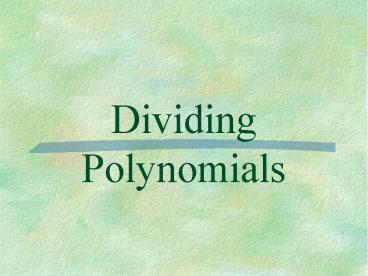Dividing Polynomials - PowerPoint PPT Presentation
Title: Dividing Polynomials
1
Dividing Polynomials
2
Simple Division -
dividing a polynomial by a monomial
3
Simplify
4
Simplify
5
Long Division -
divide a polynomial by a polynomial
- Think back to long division from 3rd grade.
- How many times does the divisor go into the
dividend? Put that number on top. - Multiply that number by the divisor and put the
result under the dividend. - Subtract and bring down the next number in the
dividend. Repeat until you have used all the
numbers in the dividend.
6
x
- 8
3x
-( )
x2
- 8x
- 24
- 8x
- 24
-( )
0
7
h2
4h
5
-( )
- 4h2
h3
- 11h
4h2
-( )
4h2
- 16h
5h
28
-( )
5h
- 20
48
8
Synthetic Division -
divide a polynomial by a polynomial
- To use synthetic division
- There must be a coefficient for every possible
power of the variable. - The divisor must have a leading coefficient of 1.
9
Step 1 Write the terms of the polynomial
so the degrees are in descending order.
10
Step 2 Write the constant r of the divisor
x-r to the left and write down the
coefficients.
Since the divisor is x-3, r3
11
Step 3 Bring down the first coefficient, 5.
12
15
13
Step 5 Repeat process multiplying the
sum, 15, by r and place this number
under the next coefficient, then add.
41
14
Step 5 cont. Repeat the same procedure.
Where did 123 and 372 come from?
124
378
15
Step 6 Write the quotient.
The numbers along the bottom are coefficients of
the power of x in descending order, starting with
the power that is one less than that of the
dividend.
16
The quotient is
Remember to place the remainder over the divisor.
17
Ex 7
Step1 Powers are all accounted for and in
descending order.
Step2 Identify r in the divisor. Since the
divisor is x4, r-4 .
18
Step3 Bring down the 1st coefficient.
Step4 Multiply and add.
Step5 Repeat.
4
-4
20
0
8
-1
1
0
-2
10
-5
19
Ex 8
Notice the leading coefficient of the divisor is
2 not 1. We must divide everything by 2 to change
the coefficient to a 1.
20
(No Transcript)
21
Remember we cannot have complex fractions - we
must simplify.
22
Ex 9
23
(No Transcript)































